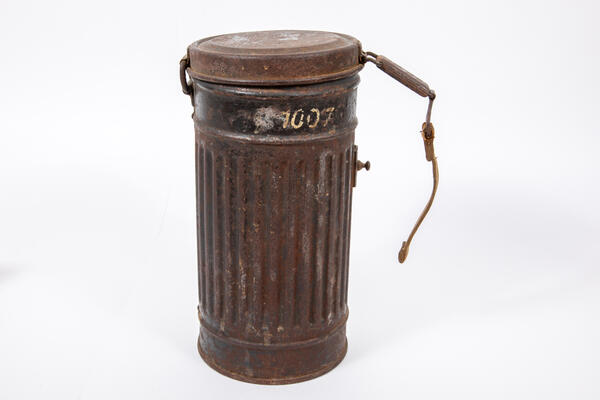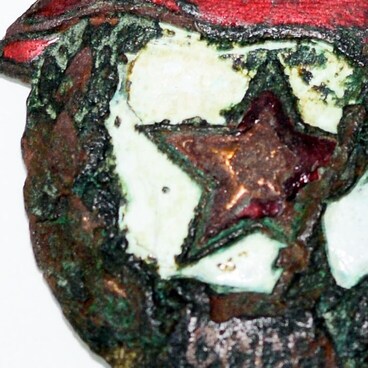During the Second World War, there were three models of gas masks used by Wehrmacht soldiers: Gasmaske 24, 30, and 38. They consisted of a filter and a gas mask. In wartime, only the personnel of the army reserve, who trained new recruits and guarded the rear, used in limited quantities the old 1924 gas masks and their cases. The 1930 models were made of rubberized fabric and leather, and the 1938 gas masks were entirely made of rubber. Both models were equipped with a round filter that was screwed onto the mask’s muzzle.
Three types of canisters were produced for gas masks (Tragbuchse fur Gasmaske). The 1930 and 1938 models were compatible with each other. A container for a 1930 gas mask is displayed in the museum. The cylindrical case is made of metal. The lid on the pin hinge is closed with a spring latch on a braided strap.
Soldiers wore the gas mask canister over the bread bag, directly under the waist belt with the lid forward, so that the gas mask could be quickly taken out. The over the shoulder strap was adjusted so that the case was almost in a horizontal position. A short supporting loop with a hook was hung on the waist belt between the left loop of the bread bag and its central supporting hook.
There were other permitted ways for wearing gas mask canisters. These methods depended on the military occupational specialty of a soldier. Machine gunners carried the canisters with the lid to the left; drivers and motorcyclists — on a shortened strap on the chest with the lid to the right; cavalrymen — on the right hip below the waist belt. However, soldiers often wore the gas mask canisters in the way they considered the most convenient.
In winter, gas mask canisters were sometimes painted with washable white paint or covered with white lime for camouflage purposes.
Each service member carried a small brown box in the lid of the gas mask canister with ten losantine tablets for skin disinfection. They were used in case of poisoning with blister agents based on mustard gas and lewisite.
Three types of canisters were produced for gas masks (Tragbuchse fur Gasmaske). The 1930 and 1938 models were compatible with each other. A container for a 1930 gas mask is displayed in the museum. The cylindrical case is made of metal. The lid on the pin hinge is closed with a spring latch on a braided strap.
Soldiers wore the gas mask canister over the bread bag, directly under the waist belt with the lid forward, so that the gas mask could be quickly taken out. The over the shoulder strap was adjusted so that the case was almost in a horizontal position. A short supporting loop with a hook was hung on the waist belt between the left loop of the bread bag and its central supporting hook.
There were other permitted ways for wearing gas mask canisters. These methods depended on the military occupational specialty of a soldier. Machine gunners carried the canisters with the lid to the left; drivers and motorcyclists — on a shortened strap on the chest with the lid to the right; cavalrymen — on the right hip below the waist belt. However, soldiers often wore the gas mask canisters in the way they considered the most convenient.
In winter, gas mask canisters were sometimes painted with washable white paint or covered with white lime for camouflage purposes.
Each service member carried a small brown box in the lid of the gas mask canister with ten losantine tablets for skin disinfection. They were used in case of poisoning with blister agents based on mustard gas and lewisite.



